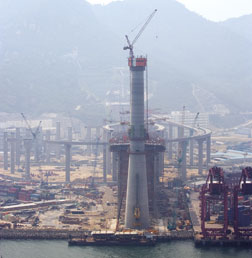Hong Kong, already home to a necklace of long-span suspension and cable-stayed bridges, is adding another to its collection. The 1.6-kilometer-long, cable-stayed Stonecutters Bridge will have a 1,018-m-long main span, slated to be the world’s second longest, to be supported from unique composite steel-and-concrete towers reaching 295 m tall. That span is scheduled to be erected next year but the project has featured controversy since its design competition, and unexpected underground conditions have followed. Hear what Arup's Bob Lind has to say in the video box below.
The $343-million dual three-lane crossing over Hong Kong’s Rambler Channel is part of a $1.7-billion, 15-km-long Route 8 highway that will link Chek Lap Kok airport on Lantau Island with the New Territories. Michael Hui, the city highway department’s chief engineer, acknowledges the debate over the need for a new highway, let alone a route that required building a very long bridge over the harbor entrance.
“There is no question that we need this alternative [route],” he says. “Whether you choose a bridge or tunnel is a matter of evaluation. In the late ’80s we evaluated a number of options. This route is the best option.”
The job drew the attention of the international engineering community, which closely watched the hotly competed global design contest unfold. London-based Halcrow Group led a team that won the design competition. Ove Arup & Partners Hong Kong Ltd., which didn't compete, won the detailed design contract. It served as the highway department’s competition advisor.
 Michael Goodman/ENR
|
 Arup Stonecutters will feature worlds second-longest
cable-stayed span. |
“When we planned this competition we were aware of the issues that might arise regarding the winner versus the development,” says Hui. “When we set the rules, we absolutely made it clear” that the contest winner would not necessarily get the design contract. “We put in the agreement that the winner would get a handsome sum—and the concept could be handed over to someone else.”
Halcrow has noted that the $128,000 prize basically covered the cost of preparing the design.
Tower Redesign
Stonecutters will be second only to China’s Sutong Bridge, now under construction with a 1,088-m-long main span, as the world’s longest cable-stayed crossing. Stonecutters is designed to have a 100+ year design life despite its location’s inevitable typhoons and corrosive marine environment, says Hui. Its redesigned towers will support slimmed cables and a slender deck that meets aesthetic requirements demanded by stakeholders. Click here to watch a video of Michael Hui talking about Route 8.
Extensive wind tunnel tests on the winning design’s monolithic, jump-formed circular bridge towers topped by a steel section from which cables would emerge led Arup to reconsider Halcrow’s plan for the steel top section. Now, the lower 175 m of reinforced concrete will continue 120 m to the top, enclosing carbon steel boxes holding the cable stays plus a 20-mm-thick stainless steel sheath that weighs 800 tonnes. The towers taper from 24 x 18 m at the base to 7-m-diameters at the apex. Click here to view a video of Michael Hui describing the stonecutters tower. Click here to watch a video of Steve Kite showing the tower.
 Hui Hui |
The project’s nine-month delay, pushing completion to early 2009, is not the fault of the redesign. The fault lies literally in the ground below the west tower. “When we began piles on the west side, we did predrills, and found no bedrock at the expected level,” says Robert Lind, Arup principal resident engineer. “We drilled to 160 m deep and there was still no competent rock.”
To avoid the clefts and voids, the team reconfigured and spread out some 30 bored piles, up to 3 m in diameter and some 110 meters deep. The west pile cap is 36.4 x 47.4 m; its east counterpart is 33.4 x 47.4 m. Each pile cap is 8 m deep, filled with 13,000 cu m of concrete. “The [additional] cost total is still to be determined, and we have to work them out with the contractor, but it will be significant,” says Lind.
 Lind Lind |
“The fissure caught all of us off guard,” adds Brian West, project manager for the mostly Japanese joint venture of Maeda-Hitachi-Yokogawa-Hsin Chong. It holds a $350-million general contract, awarded in 2004. Although the team received a six-month completion extension, it still faces potential liquidated damages. In general, the team faces some $30,000 a day in fines after June 2009, says Hui.
Work has proceeded smoothly so far on 579 m of concrete backspans on either side of the channel that seem to march in giant formation to the water. The cast-in-place box girders require a massive system of falsework up to 60 m high. Braced with three levels of steel, the temporary precast concrete towers comprise 2-sq-m stacked boxes, weighing up to 16,000 tonnes, says Hui.
 West West |
The cast-in-place concrete box girders essentially match steel box girders that will make up the main span, to provide continuity of visual appearance. “The backspan design is segregated by a host of longitudinal and transverse diaphragms,” notes West. Click here to watch a video of Brian West talking about backspans and cable strands.
Averaging 75 m in length, each cast-in-place, 18-m-wide backspan require 21 pours and takes about 45 days, West says. Because they cannot support their own weight and counterbalance the extreme length of the future main span, falsework must stay in place until the cables are installed. “Normally, you’d erect the falsework, construct the deck, apply any necessary post-tensioning and then tear down the support,” notes West. “Here, as a result of the required construction sequence, the falsework...
 Stonecutters Cable:
Stonecutters Cable: Stonecutters Bridge:
Stonecutters Bridge: Falsework:
Falsework: Backspans & Cable Strands:
Backspans & Cable Strands: Route 8:
Route 8: Towers:
Towers: Composite Tower:
Composite Tower: ENR Reports:
ENR Reports:
Post a comment to this article
Report Abusive Comment